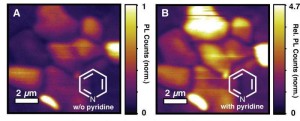Topic Close-up #5
Symposium: B07—Light Energy Conversion with Metal Halide Perovskites, Inorganic/Organic Hybrid Materials, and Dynamic Exciton
For more information on 245th ECS Meeting symposia, consult additional topic close-ups.
Symposium: B07—Light Energy Conversion with Metal Halide Perovskites, Inorganic/Organic Hybrid Materials, and Dynamic Exciton
For more information on 245th ECS Meeting symposia, consult additional topic close-ups.
Perovskite-based solar cells are all around great. They offer energy efficiencies similar to those of traditional silicon-based cells, are lightweight, simple and cheap to produce, and offer physical flexibility that could unlock a wide new range of installation methods and places, according to Georgia Teach Research Horizons.
The only problem: figuring out how to produce perovskite-based energy devices that last longer than a couple of months.
Researchers at Georgia Institute of Technology, University of California San Diego, and Massachusetts Institute of Technology may be closer to solving that problem. (more…)

This new development will lead to accelerated improvements in the materials’ uniformity, stability, and efficiency.
Source: University of Washington
In light of the growth in solar energy research, scientists have been directing a lot of attention toward perovskites. The materials’ wide range of use and potential to outpace silicon-based semiconductors in the field of solar cells makes perovskites an interesting area of research with great potential.
Researchers from the University of Washington, in conjunction with the University of Oxford, have discovered a new quality to perovskites that could help engineer a better solar cell.
The researchers have shown in their research that, contrast to popular belief, the perovskites are uniform in composition. The materials actually contain flaws that can be engineered to improve solar devices even further.
“In that short amount of time, the ability of these materials to convert sunlight directly into electricity is approaching that of today’s silicon-based solar cells, rivaling technology that took 50 years to develop,” said Dane deQuilettes, a University of Washington doctoral student. “But we also suspect there is room for improvement.”